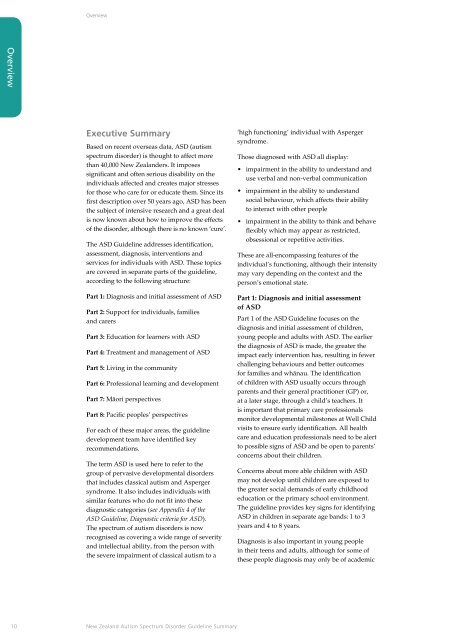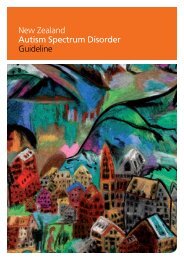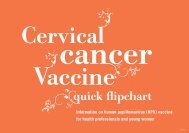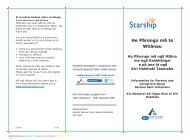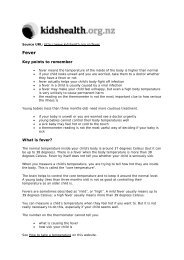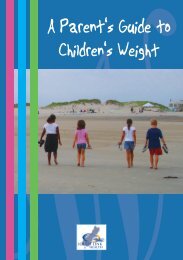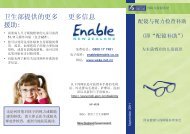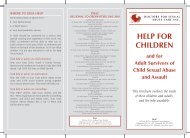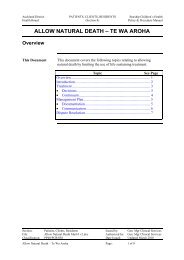New Zealand Autism Spectrum Disorder ... - Ministry of Health
New Zealand Autism Spectrum Disorder ... - Ministry of Health
New Zealand Autism Spectrum Disorder ... - Ministry of Health
You also want an ePaper? Increase the reach of your titles
YUMPU automatically turns print PDFs into web optimized ePapers that Google loves.
Overview<br />
Overview<br />
Executive Summary<br />
Based on recent overseas data, ASD (autism<br />
spectrum disorder) is thought to affect more<br />
than 40,000 <strong>New</strong> <strong>Zealand</strong>ers. It imposes<br />
significant and <strong>of</strong>ten serious disability on the<br />
individuals affected and creates major stresses<br />
for those who care for or educate them. Since its<br />
first description over 50 years ago, ASD has been<br />
the subject <strong>of</strong> intensive research and a great deal<br />
is now known about how to improve the effects<br />
<strong>of</strong> the disorder, although there is no known ‘cure’.<br />
The ASD Guideline addresses identification,<br />
assessment, diagnosis, interventions and<br />
services for individuals with ASD. These topics<br />
are covered in separate parts <strong>of</strong> the guideline,<br />
according to the following structure:<br />
Part 1: Diagnosis and initial assessment <strong>of</strong> ASD<br />
Part 2: Support for individuals, families<br />
and carers<br />
Part 3: Education for learners with ASD<br />
Part 4: Treatment and management <strong>of</strong> ASD<br />
Part 5: Living in the community<br />
Part 6: Pr<strong>of</strong>essional learning and development<br />
Part 7: Mäori perspectives<br />
Part 8: Pacific peoples’ perspectives<br />
For each <strong>of</strong> these major areas, the guideline<br />
development team have identified key<br />
recommendations.<br />
The term ASD is used here to refer to the<br />
group <strong>of</strong> pervasive developmental disorders<br />
that includes classical autism and Asperger<br />
syndrome. It also includes individuals with<br />
similar features who do not fit into these<br />
diagnostic categories (see Appendix 4 <strong>of</strong> the<br />
ASD Guideline, Diagnostic criteria for ASD).<br />
The spectrum <strong>of</strong> autism disorders is now<br />
recognised as covering a wide range <strong>of</strong> severity<br />
and intellectual ability, from the person with<br />
the severe impairment <strong>of</strong> classical autism to a<br />
‘high functioning’ individual with Asperger<br />
syndrome.<br />
Those diagnosed with ASD all display:<br />
• impairment in the ability to understand and<br />
use verbal and non-verbal communication<br />
• impairment in the ability to understand<br />
social behaviour, which affects their ability<br />
to interact with other people<br />
• impairment in the ability to think and behave<br />
flexibly which may appear as restricted,<br />
obsessional or repetitive activities.<br />
These are all-encompassing features <strong>of</strong> the<br />
individual’s functioning, although their intensity<br />
may vary depending on the context and the<br />
person’s emotional state.<br />
Part 1: Diagnosis and initial assessment<br />
<strong>of</strong> ASD<br />
Part 1 <strong>of</strong> the ASD Guideline focuses on the<br />
diagnosis and initial assessment <strong>of</strong> children,<br />
young people and adults with ASD. The earlier<br />
the diagnosis <strong>of</strong> ASD is made, the greater the<br />
impact early intervention has, resulting in fewer<br />
challenging behaviours and better outcomes<br />
for families and whänau. The identification<br />
<strong>of</strong> children with ASD usually occurs through<br />
parents and their general practitioner (GP) or,<br />
at a later stage, through a child’s teachers. It<br />
is important that primary care pr<strong>of</strong>essionals<br />
monitor developmental milestones at Well Child<br />
visits to ensure early identification. All health<br />
care and education pr<strong>of</strong>essionals need to be alert<br />
to possible signs <strong>of</strong> ASD and be open to parents’<br />
concerns about their children.<br />
Concerns about more able children with ASD<br />
may not develop until children are exposed to<br />
the greater social demands <strong>of</strong> early childhood<br />
education or the primary school environment.<br />
The guideline provides key signs for identifying<br />
ASD in children in separate age bands: 1 to 3<br />
years and 4 to 8 years.<br />
Diagnosis is also important in young people<br />
in their teens and adults, although for some <strong>of</strong><br />
these people diagnosis may only be <strong>of</strong> academic<br />
10<br />
<strong>New</strong> <strong>Zealand</strong> <strong>Autism</strong> <strong>Spectrum</strong> <strong>Disorder</strong> Guideline Summary


